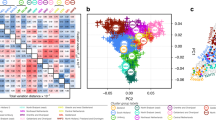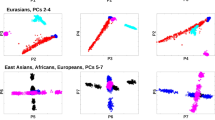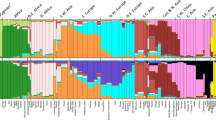Abstract
Characterizing genetic diversity within and between populations has broad applications in studies of human disease and evolution. We propose a new approach, spatial ancestry analysis, for the modeling of genotypes in two- or three-dimensional space. In spatial ancestry analysis (SPA), we explicitly model the spatial distribution of each SNP by assigning an allele frequency as a continuous function in geographic space. We show that the explicit modeling of the allele frequency allows individuals to be localized on the map on the basis of their genetic information alone. We apply our SPA method to a European and a worldwide population genetic variation data set and identify SNPs showing large gradients in allele frequency, and we suggest these as candidate regions under selection. These regions include SNPs in the well-characterized LCT region, as well as at loci including FOXP2, OCA2 and LRP1B.
This is a preview of subscription content, access via your institution
Access options
Subscribe to this journal
Receive 12 print issues and online access
$209.00 per year
only $17.42 per issue
Buy this article
- Purchase on Springer Link
- Instant access to full article PDF
Prices may be subject to local taxes which are calculated during checkout





Similar content being viewed by others
References
Price, A.L. et al. Principal components analysis corrects for stratification in genome-wide association studies. Nat. Genet. 38, 904–909 (2006).
Seldin, M.F., Pasaniuc, B. & Price, A.L. New approaches to disease mapping in admixed populations. Nat. Rev. Genet. 12, 523–528 (2011).
Lewontin, R.C. & Krakauer, J. Distribution of gene frequency as a test of the theory of the selective neutrality of polymorphisms. Genetics 74, 175–195 (1973).
Pickrell, J.K. et al. Signals of recent positive selection in a worldwide sample of human populations. Genome Res. 19, 826–837 (2009).
Coop, G. et al. The role of geography in human adaptation. PLoS Genet. 5, e1000500 (2009).
Jakobsson, M. et al. Genotype, haplotype and copy-number variation in worldwide human populations. Nature 451, 998–1003 (2008).
Li, J.Z. et al. Worldwide human relationships inferred from genome-wide patterns of variation. Science 319, 1100–1104 (2008).
Lao, O. et al. Correlation between genetic and geographic structure in Europe. Curr. Biol. 18, 1241–1248 (2008).
Novembre, J. et al. Genes mirror geography within Europe. Nature 456, 98–101 (2008).
Novembre, J. & Stephens, M. Interpreting principal component analyses of spatial population genetic variation. Nat. Genet. 40, 646–649 (2008).
McVean, G. A genealogical interpretation of principal components analysis. PLoS Genet. 5, e1000686 (2009).
Novembre, J. & Di Rienzo, A. Spatial patterns of variation due to natural selection in humans. Nat. Rev. Genet. 10, 745–755 (2009).
Excoffier, L. & Ray, N. Surfing during population expansions promotes genetic revolutions and structuration. Trends Ecol. Evol. 23, 347–351 (2008).
Voight, B.F., Kudaravalli, S., Wen, X. & Pritchard, J.K. A map of recent positive selection in the human genome. PLoS Biol. 4, e72 (2006).
Holsinger, K.E. & Weir, B.S. Genetics in geographically structured populations: defining, estimating and interpreting FST . Nat. Rev. Genet. 10, 639–650 (2009).
Coop, G., Witonsky, D., Di Rienzo, A. & Pritchard, J.K. Using environmental correlations to identify loci underlying local adaptation. Genetics 185, 1411–1423 (2010).
Nelson, M.R. et al. The population reference sample, POPRES: a resource for population, disease, and pharmacological genetics research. Am. J. Hum. Genet. 83, 347–358 (2008).
Sabeti, P.C. et al. Detecting recent positive selection in the human genome from haplotype structure. Nature 419, 832–837 (2002).
Bersaglieri, T. et al. Genetic signatures of strong recent positive selection at the lactase gene. Am. J. Hum. Genet. 74, 1111–1120 (2004).
Enard, W. et al. Molecular evolution of FOXP2, a gene involved in speech and language. Nature 418, 869–872 (2002).
Liu, C.X., Musco, S., Lisitsina, N.M., Yaklichkin, S.Y. & Lisitsyn, N.A. Genomic organization of a new candidate tumor suppressor gene, LRP2B. Genomics 69, 271–274 (2000).
Nocedal, J. & Wright, S.J. Numerical Optimization (Springer, New York, 2000).
Acknowledgements
W.-Y.Y. and E.E. are supported by grants from the US National Science Foundation (0513612, 0731455, 0729049, 0916676 and 1065276) and the US National Institutes of Health (K25 HL080079, U01 DA024417, P01 HL30568 and PO1 HL28481). J.N. is supported by National Science Foundation grant (0933731) and by the Searle Scholars Program. E.H. is a faculty fellow of the Edmond J. Safra Program at Tel Aviv University and was supported in part by the Israeli Science Foundation (grant 04514831) and by IBM open collaborative research award program.
Author information
Authors and Affiliations
Contributions
W.-Y.Y., J.N., E.E. and E.H. designed the methods and experiments. W.-Y.Y. implemented the methods. W.-Y.Y., J.N., E.E. and E.H. jointly performed the analysis. All authors discussed the results and contributed to the writing of the manuscript.
Corresponding author
Ethics declarations
Competing interests
The authors declare no competing financial interests.
Supplementary information
Supplementary Text and Figures
Supplementary Figures 1–5, Supplementary Tables 1–4 and Supplementary Note (PDF 652 kb)
Rights and permissions
About this article
Cite this article
Yang, WY., Novembre, J., Eskin, E. et al. A model-based approach for analysis of spatial structure in genetic data. Nat Genet 44, 725–731 (2012). https://doi.org/10.1038/ng.2285
Received:
Accepted:
Published:
Issue Date:
DOI: https://doi.org/10.1038/ng.2285
This article is cited by
-
Conservation genetics of Phlox hirsuta, a serpentine endemic
Conservation Genetics (2023)
-
Recent natural selection conferred protection against schizophrenia by non-antagonistic pleiotropy
Scientific Reports (2023)
-
Predicting the geographic origin of Spanish Cedar (Cedrela odorata L.) based on DNA variation
Conservation Genetics (2020)
-
Conserved noncoding sequences conserve biological networks and influence genome evolution
Heredity (2018)
-
Understanding 6th-century barbarian social organization and migration through paleogenomics
Nature Communications (2018)



